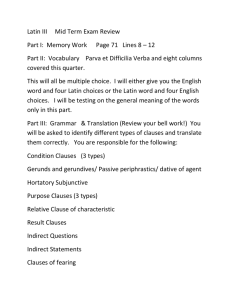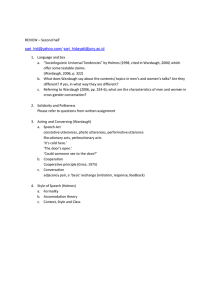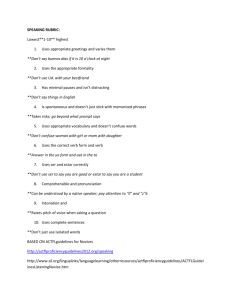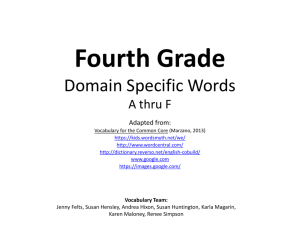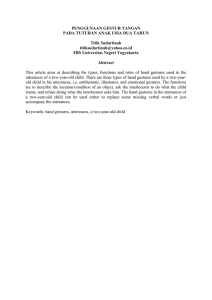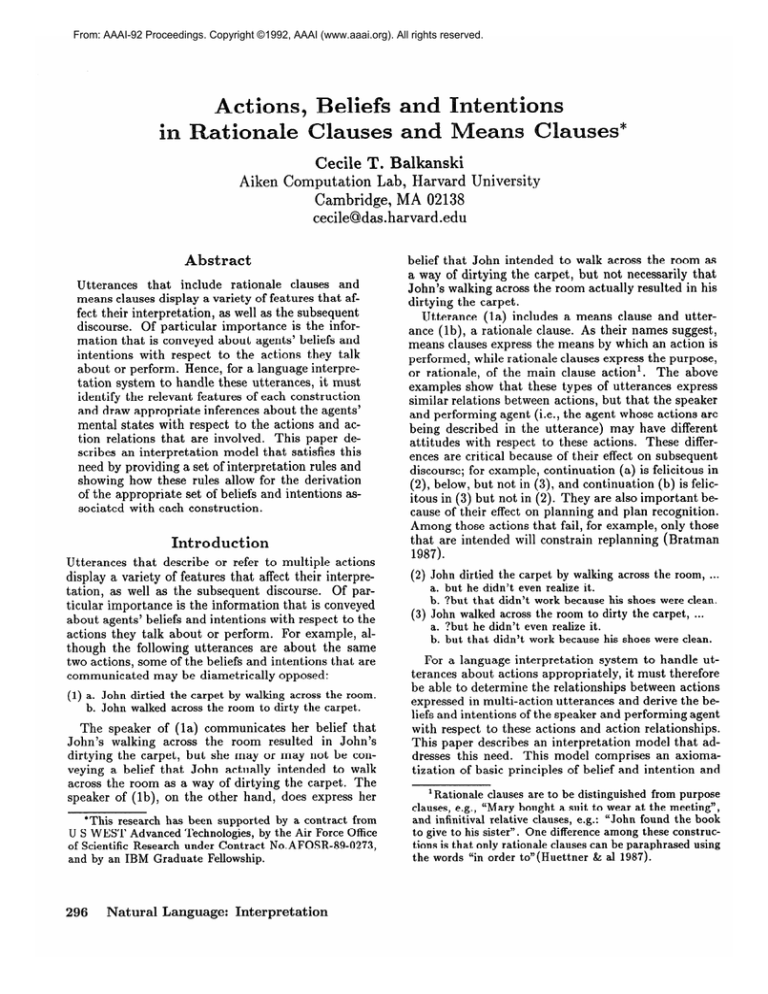
From: AAAI-92 Proceedings. Copyright ©1992, AAAI (www.aaai.org). All rights reserved.
Actions,
at ionale Clauses and
ses*
Cecile T. Balkanski
Aiken Computation Lab, Harvard University
Cambridge, MA 02138
cecile@das. harvard .edu
Abstract
that include rationale
clauses and
means clauses display a variety of features that affect their interpretation,
as well as the subsequent
Utterances
discourse.
Of particular
mation that is conveyed
intentions
with respect
about or perform.
importance
is the inforabout agents’ beliefs and
to the actions they talk
Hence, for a language
interpre-
tation system to handle these utterances,
it must
identify the relevant features of each construction
and draw appropriate
inferences about the agents’
mental states with respect to the actions and action relations that are involved.
This paper describes an interpretation
model that satisfies this
need by providing a set of interpretation
rules and
showing how these rules allow for the derivation
of the appropriate set of beliefs and intentions associated with each construction.
Introduction
Utterances
that describe or refer to multiple actions
display a variety of features that affect their interpretation, as well as the subsequent
discourse.
Of particular importance
is the information
that is conveyed
about agents’ beliefs and intentions
with respect to the
actions they talk about or perform.
For example, although the following utterances
are about the same
two actions, some of the beliefs and intentions
that are
communicated
may be diametrically
opposed:
(1) a. John dirtied the carpet by walking across the room.
b. John walked across the room to dirty the carpet.
The
John’s
dirtying
veying
across
speaker
speaker of (la) communicates
her belief that
walking across the room resulted
in John’s
the carpet, but she may or may not be cona belief that John actually
intended
to walk
the room as a way of dirtying the carpet. The
of (lb), on the other hand, does express her
*This research has been supported by a contract from
U S WEST Advanced Technologies, by the Air Force Office
of Scientific Research under Contract No.AFOSR-89-0273,
and by an IBM Graduate
Fellowship.
296
Natural Language:
Interpretation
belief that John intended to walk across the room as
a way of dirtying the carpet, but not necessarily that
John’s walking across the room actually resulted in his
dirtying the carpet.
Utterance
(la) includes a means clause and utterance (lb), a rationale clause. As their names suggest,
means clauses express the means by which an action is
performed, while rationale clauses express the purpose,
or rationale,
of the main clause action’.
The above
examples
show that
these types of utterances
express
similar relations between actions, but that the speaker
and performing agent (i.e., the agent whose actions are
being described in the utterance)
may have different
attitudes
with respect to these actions.
These differences are critical because of their effect on subsequent
discourse; for example, continuation
(a) is felicitous in
(2)) below, but not in (3)) and continuation
(b) is felic-
itous in (3) but not in (2). They are also important
because of their effect on planning and plan recognition.
Among those actions that fail, for example, only those
that are intended will constrain
replanning
(Bratman
1987).
(2) John dirtied th e carpet by walking across the room, . . .
a. but he didn’t even realize it.
b. ?but that didn’t work because his shoes were clean.
(3) John walked across the room to dirty the carpet,
.. .
a. ?but he didn’t even realize it.
b. but that didn’t work because his shoes were clean.
For a language interpretation
system to handle utterances about actions appropriately,
it must therefore
be able to determine the relationships
between actions
expressed
in multi-action
utterances
and derive the be-
liefs and intentions of the speaker and performing agent
with respect to these actions and action relationships.
This paper describes an interpretation
model that addresses this need. This model comprises an axiomatization of basic principles of belief and intention and
from purpose
‘Rationale
c lauses are to be distinguished
clauses, e.g., “Mary bought a suit to wear at the meeting”,
and infinitival relative clauses, e.g.: “John found the book
to give to his sister”. One difference among these constructions is that only rationale clauses can be paraphrased
using
the words “in order to”(Huettner
& al 1987).
a set of interpretation
rules for deriving the action relations expressed in these utterances.
It thereby accounts for both the overlap and the difference in meaning between utterances
with rationale clauses and utterances with means clauses, as illustrated
in (l), (2)
and (3). While utterances
with rationale clauses may
be about sequential
or simultaneous
actions (Balkanski 1992), this paper focuses on utterances
concerning
simultaneous
actions.
This paper extends a companion
paper (Balkanski
1992) in addressing
the mental states of the speaker
and performing
agent and in considering
utterances
about present and future, as well as past actions. Surprisingly little research has addressed the interpretation of means clauses and rationale clauses. There is a
large body of linguistics
research on purpose clauses,
but it focuses on syntactic
aspects of the construction
and issues of control (e.g., Bach (1982), Jones (1991)).
The planning
literature
provides very useful theories
of action and action relations,
which will be referred
to later in this paper. In the computational
linguistics
literature,
Huettner’s
work on the generation
of adjunct clauses (Huettner
& al 1987) and Di Eugenio’s
analysis of instructions
(Webber & Di Eugenio 1990;
Di Eugenio 1992) both examine purpose constructions,
but from different perspectives
than that of this paper.
Huettner focuses on decision making in the generation
process, e.g., determining
which argument
to gap (i.e.,
delete) when. Di Eugenio uses action relations similar
to those presented here, but does not address issues regarding differences in the mental states of the speaker
and performing
agent, temporal aspects of action occurrences, or the role of contextual
conditions,
all of
which are central to this paper.
eliefs and intentions expressed in
utterances with rationale and means
clauses
This section examines in more detail the characteristic beliefs and intentions
expressed in utterances
with
rationale clauses and means clauses. These properties,
illustrated
in (1)) (2) and (3), emerged from a detailed
analysis of multi-action
utterances
in task-oriented
dialogues (Balkanski 1990) and a subsequent
examination
of selections from Associated Press news stories.
Utterances
with rationale
clauses or means clauses
are about two actions, the occurrence
of one of them
1970), i.e., resulting in,
possibly generating (Goldman
the simultaneous
performance
of the other2.
The
generation
relation, independently
motivated
by work
in plan recognition
(Pollack
1986; Balkanski
1990;
Lochbaum
1991), holds of two actions A and B when
(a) their agents and times are the same, (b) there is a
2Because
utterances
with rationale clauses are not restricted to simultaneous
actions, they are not restricted
to
the generation
relation either; the general case in treated
in the companion
paper (Balkanski
1992).
set of contextual
conditions, called generation-enabling
conditions
(e.g., John’s shoes being dirty) that hold
during performance
time and (c) there is a conditional
generation
relation between the act-type of A, the acttype of B and these conditions.
A conditional
generation relation holds among act-types
o and /3 and
conditions
C if whenever an action of type cy occurs
while these conditions
hold, an action of type p occurs at the same time. In this paper, the generation
relation will be notated as GEN(A,B)
where A and B
are actions, comprising
an act-type,
agent and time
(Balkanski
1990). A n important
property of this relation is that if it holds of two actions A and B, and A
occurs, then so does B. This follows from the generation relation requiring the relevant generation-enabling
conditions to hold during performance
time.
Utterances with means clauses and rationale clauses,
therefore, refer to both a generating and a generated action, performed by the same agent at the same time.
In utterances
with means clauses (MC), the generating
action is expressed in the adjunct clause, whereas in utterances with rationale clauses (RC), it is expressed in
the matrix clause. Let A represent the generating
action (e.g., John’s walking across the room during some
time interval) and B the generated action (e.g., John’s
dirtying the carpet during that time interval).
Let S
be the speaker, G the performing
agent, T, the time
of speech, and T, the time of action (past, present or
future).
The beliefs and intentions
expressed in these
two types of utterances are the following:
14 In
both types of utterances,
S believes that A
occurred (respectively,
is occurring, will occur).
PI In utterances with MCs, but not necessarily
those with RCs, S believes that B occurred (is
occurring, will occur).
[cl In utterances with MCs, but not necessarily
those with RCs, S believes that GEN(A,B).
In the MC case, therefore,
but not necessarily in the RC case, S believes there is a conditional generation relation between the act-types
of A and B and some set of generation-enabling
conditions,
and that these conditions
held (are
holding, will hold).
idI In utterances with RCs, but not necessarily
those with MCs, S believes that A was intended
(will be intended)
on the part of G.
In
utterances
with
RCs, but not necessarily
H
those with MCs, S believes that B was intended
(will be intended) on the part of G.
IfI In utterances with RCs, but not necessarily
those with MCs, S believes that A was intended
(will be intended)
on the part of G us a way of
generating
B. In the RC case, therefore, but not
necessarily in the MC case, S believes that G expects (at the start of action time) the relevant
generation-enabling
conditions
to hold.
The belief in [a] is readily
associated
with these ut-
Balkanski
297
terances.
Those in [b],[c], [e] and [f] were illustrated
in (l), (2) and (3). Although the belief in [d] is likely
to hold of utterances
with means clauses like (2) (i.e.,
the walking action was probably intended on the part
of John), this need not be the case, as illustrated
in
(4a) below.
Utterance
(4b) shows that the use of a
rationale clause forces an interpretation
in which the
speaker believes that the generating
action (here the
slipping action) is intended on the part of its agent.
(4) a. John
b. John
broke his arm by slipping on the ice.
slipped on the ice to break his arm.
The beliefs and intentions
listed above are formalized
in (5); their truth values with respect to utterances
with rationale clauses and means clauses are given in
Table 1, where a “1” indicates that the corresponding
belief is true, and a “?” that it can be true or false,
depending on the context.
(5) [a]
[b]
[c]
[d]
[e]
[f]
BEL(S,
BEL(S,
BEL(S,
BEL(S,
BEL(S,
BEL(S,
Utterances
Utterances
Table
T,,
TJ,
‘L,
T,,
T,,
T,,
OCCUR(A))
OCCUR(B))
GEN(A,B))
INT(G,start(T,),act-type(A),T,))
INT(G,start(T,),act-type(B),T,))
INT(G,start(T,),
act-type(A)
& GEN(A,B),
Beliefs:
with RCs:
with MCs:
1
1
1
?
?
1: Beliefs and intentions
expressed
utterances
with MCs and RCs
T,))
?
in
The functions “start” and “act-type” return, respectively, the starting point of a time interval and the acttype of an action (e.g., the act-type “dirty the carpet”
for the action of John’s dirtying the carpet during T).
The predicate BEL holds of an agent, a time (interval)
and a proposition
if the agent believes the proposition during that time. The predicate
OCCUR holds
of an action if that action occurs.
Because actions
have associated
times, the OCCUR predicate inherits
its time from its argument.
When the time of action
A is past, then OCCUR(A)
is true if A occurred in the
past; when the time of A is present, then OCCUR(A)
is true if A is an action currently being performed; finally, when the time of A is future, then OCCUR(A)
is true if A is an action that will necessarily
occur
in the future.
Although it is impossible to determine
whether an action will necessarily occur in the future,
when used in belief contexts (as in this paper), this
predicate make claims about an agent’s beliefs about
the past, present or future occurrence
of actions. The
predicate INT holds of an agent, a time (point) Ti , an
act-type, and a time (interval) T2 if the agent intends
at Tr to perform an action of that type during T2.
Because Tr =start(Ts)
in [d], [e] and [f], these beliefs
are about present-directed
intentions
(Bratman
1987).
298
Natural
Language:
Interpretation
Whether or not G also had, at an earlier time, a futuredirected intention
to perform an action of type A (or
) is not of concern here3. The GEN relation in [f]
is used as a modifier indicating
the way in which an
action is performed.
That is, INT(G, Ti , act-type(A)
8~ GEN(A,B), 3’2)) means that G intends at Tr to perform an action of the type of A during T2 us a way of
generating
B (Lochbaum
& al 1990).
The beliefs represented
in Table 1 hold for past,
present and future actions, as indicated
by the verb
tenses used in the English descriptions.
The examples in the Introduction
were about past actions, but
the same acceptability
judgments
are obtained
with
present and future actions.
For example, in uttering
(6a), below, S may have reason to believe that Mary’s
keeping Sue up is unintentional,
or, in uttering
(6b),
that John will fail to reset the printer.
(6) a. Mary is keeping S ue up by playing the piano.
b. John will press the red button to reset the printer.
These beliefs also hold for utterances
in which the
speaker and the agent are the same person.
For example, the speaker of (7a), below, believes that she
intended to extend her arm out of the window [d], intended to signal for a left turn [e], and intended
to
extend her arm as a way of signaling for a turn [f].
She also believes that she extended
her arm [a], but
not necessarily that in doing so, she signaled for a turn
[b],[c] (e.g., maybe she knows that the driver behind
her could not see her arm). Similar results obtain for
present and future actions.
For example, the speaker
of (7b) may have doubts about her success in signaling
for a turn. In utterances
with means clauses, e.g. (7c),
the speaker may or may not intend to dirty the carpet
even if she believes that she is doing so (or will do ~0)~.
So beliefs [e] and [f] can be true or false, as desired,
despite the speaker’s having beliefs [b] and [cl.
(7) a. I extended my arm out of the car window to signal
for a left turn.
b. I am extending
(or will extend) my arm out of the
window to signal for a turn.
c. I am getting (or will get) the carpet dirty by
walking across the room.
The goal of the analysis presented in the remainder
of this paper is to derive the beliefs and intentions given
in Table 1. These beliefs and intentions
will be derived
on the basis of the logical form of an utterance,
a set of
axioms about belief and intention,
and interpretation
rules defining the meaning of the relevant linguistic
constructions.
3We are also not concerned with the performing agent’s
intentions
during action time, since when an agent is actually performing
an action A, we no longer say that he
intends to A (Bratman
1987).
4This distinction
co rresponds to the difference between
doing A intentionally
and intending
to do A (Bratman
1987).
roeessing framework
This section presents the logical forms that are input
to the interpretation
model, and a set of axioms about
belief and intention that are necessary for the interpretation process.
Logical
forms
Logical forms represent
the literal meaning of an utterance and are derived compositionally
by semantic
interpretation
rules based on the syntactic structure of
the utterance.
We present here the main aspects of our
representations;
a detailed description
is given in the
companion
paper (Balkanski
1992). Our logical forms
reify actions (Davidson
1967) and are represented
as
existentially
quantified
sentences
of first-order
logic,
with predicates
that include an additional
argument
position for the action being described.
Multi-action
utterances
are handled by introducing
multiple action
variables and by representing
connectives like “by” and
“to” using two-place predicates ranging over these action variables, as illustrated
in (8)5.
(8) John will dirty the carpet by walking across the room.
LF: 3x1, x2, dirty(x2)
A agt(xz, John)/\
obj(x2, Carpet) A future(x2)A
wdk(x~)
A ioc(x~, Room) A by(x2, XI)
b.
John will walk across the room to dirty
LF: 3x1, x2, walk(x:1) A agt(xl, John)/\
~oc(xl, Room) A future(
dirty(x2) A obj( x2, carpet)
the carpet.
A to( XI, x2)
Every action argument
is represented
as a separate
predicate to avoid having either to introduce existential
variables for missing arguments
or to determine
how
these arguments
are recovered during the process of
building the logical form. As will be shown later in this
paper, the missing agent and time arguments
of the
adjunct clause actions in the logical forms in (8) will
be recovered through the interpretation
of the action
relations.
“real” action tokens, action
Rather than denoting
variables in our formalism
correspond
to action entities in the discourse model that may represent either
actual (i.e., “real”) actions, namely, actions that have
occurred,
or unrealized
actions, that is, actions that
have not yet occurred or might never occur (Balkanski
1991). Quantification
is therefore over a universe that
contains
everything
commitment
Hobbs
mapping
(1985),
from
that
to existence
Schubert
action
an issue relevant
can
be talked
in the
real
& Hwang
variables
to the main
(1990)).
to action
topic
about,
world
with
no
(as in, e.g.,
Since the
entities
is not
of this paper,
we
5 Extensional
representations
of propositions,
like this
one, have difficulties with respect
to certain
intensional
phenomena
such as substitution
of identicals.
Hobbs discusses this problem
and a number of possible solutions
(Hobbs 1985), but these questions lie beyond the scope of
the present paper.
assume from here forward that action variables have
been replaced by their corresponding
action entities.
Axioms
Agents’ beliefs are taken to be closed under logical consequence and distributive
over conjunctions:
Closure:
BEL(g, t, p)A BEL(g, t, p --) q) +
BEL(g,
Distributivity:
t, a)
BEL(g, t, pl A . . . A p,) 4
BEL(g,
t, PI) A . . .A BEL(g,t,pn)
Agents uttering a declarative
sentence are assumed
to believe the propositional
content of that utterance6:
eclarative rule: UTTER(s,
where “p” is a declarative
t,“p”) + BEL(s, t, p)
utterance
and p its LF.
We also adopt an intention axiom, 11, assumed to be
believed by all agents, that states necessary conditions
on an agent’s intention
to perform an action as a way
of generating
another. According to 11, if G intends at
ti to do o at t2 as a way of generating
b, then he must
intend to do cy at t2 and to do ,/3 at t2, and he must
believe that the two actions are related by generation
(Pollack 1986).
11: INT(g, tl, a & GEN(a,
INT(g,
t19 a, t2)A
BE%
tl SEW,
where cy = act-type(u)
b), t2) +
INT(g,
tl, P, &)A
b))
and ,0 = act-type(b)
Interpretation
The process of interpreting
a logical form consists in
applying interpretation
rules to the various predicates
of that logical form. This section presents these rules
and describes the way in which the appropriate
beliefs
and intentions
expressed in utterances
with rationale
and means clauses are derived on the basis of them. To
emphasize the fact that reasoning takes place in belief
contexts,
interpretation
rules are embedded
in belief
predicates.
Interpretation
rules
The inference
rules defining the meaning
of means
clauses and rationale
clauses are given below. They
formalize those given in the companion paper (Balkanski 1992) and extend them in a number of ways, as discussed below. The by and to predicates in the left hand
side of the rules are the logical form predicates representing the NL connectives
introducing
means clauses
and rationale clauses. Note that the order of the arguments in the by and GEN predicates is reversed.
6A more complete
treatment
of declaratives
would require a complex
theory of speech acts (e.g.,
Cohen &
Levesque (1990),
Perrault
(1990));
these topics, however,
lie beyond the scope of this paper.
Balkanski
299
LF1:
LF2:
BEL(s, t, by@, a) + GEN(a, b) A OCCUR(a))
BEL(s, t, to(a, b) INT(agt(a),
start(time(a)),
act-type(a)
& GEN(a, b), time(u)))
The LFl rule maps the LF representation
of means
clauses to the generation
relation,
capturing
the fact
that the speaker of an utterance
with a means clause
believes that the occurrence
of the main clause action
follows from that of the adjunct
clause action.
The
second conjunct of this rule specifies the speaker’s belief of the occurrence
of the generating
action.
This
occurrence is indeed a feature of the means clause construction
and not of the form of the verb, namely a
gerund; as explained
below, the occurrence
of an action may be derived from certain tensed verbs.
The LF2 rule maps the LF representation
of these
constructions
to the performing
agent’s intention
to
perform the main clause action as a way of generating
the adjunct clause action.
By virtue of intention
axiom 11, it then follows that the speaker of an utterance
with a rationale clause believes that the agent believes
(believed,
or will believe) that these actions are related by generation
(in addition to believing that the
agent intended
(or will intend) to perform both actions).
Given that the speaker may believe that the
agent’s beliefs are incorrect, the generation
relation in
these utterances
is, in a sense, only potential.
This is
as desired since, as discussed earlier, the speaker does
not necessarily believe that a generation
relation actually holds between the two actions that are referred to
in the utterance.
In the companion
paper (Balkanski
1992), we discussed the potentiality
of the generation
relation in
utterances
with rationale clauses, but did not propose
a way of capturing
it. In this paper, casting the analysis in the context of the beliefs and intentions
of the
speaker and performing
agent allows for a very simple and elegant treatment
of this aspect of rationale
clauses.
The form of a verb may sometimes
provide information about the occurrence
of the associated action.
For example, a past tense (action) verb indicates the
speaker’s belief that the corresponding
action occurred.
Similarly, a present or future tense verb indicates the
speaker’s belief of the present or future occurrence of
the associated action. Tensed verbs are represented
in
the logical form by the predicates
past, present or future, as illustrated
in (8). The following inference rule
captures the fact that these predicates
express assertions about action occurrences:
LF3:
BEL(g, t,past(a)
V present(a)
OCCUR(a))
Applying
V future(a)
+
the rules
This section illustrates
the interpretation
process by
applying the interpretation
rules and axioms presented
in the preceding sections to the sample utterances
and
300
Natural
Language:
Interpretation
logical forms in (8), thereby showing how the beliefs
and intentions
recapitulated
in Table 1, are derived.
As mentioned
earlier, action variables are assumed to
have been replaced by action constants
(let ~1 and 22
be replaced by A and B respectively).
The logical
forms under consideration
are therefore conjunctions
of ground literals.
By the Declarative
rule, the speaker,
S, believes
these logical forms and by the Distributivity
rule, S believes each conjunct of those propositions,
and in particular the one expressing the action relation, namely:
(9) MC case: BEL(S,
RC case: BEL(S,
T,,
T,,
by(B,A))
to(A,B))
The beliefs in (10) then follow from (9) and the interpretation
rules LFl and LF2 (along with the Closure
and Distributivity
axioms):
(10) MC case: BEL(S, T,, GEN(A,B))
A
BEL(S, T,, OCCUR(A))
i.e., beliefs [c] and [a] from Table
1.
RC case: BEL(S,T,,INT(agt(A),
start(time(A)),
act-type(A)&GEN(A,B),
time(A)))
i.e., belief [f] from Table 1.
In the RC case, it follows from S’s belief of intention axiom 11 that S also believes that the agent of A
believed (believes, or will believe) that A and B are
related by generation:
(11) RC case: BEL(S,T,
,BEL(agt(A),start(time(A)),
GEN(A,B)))
Because S only believes that the performing
agent
believed (believes or will believe) a GEN relation between A and B, S herself may or.may not believe that
relation, depending
on whether or not S believes the
agent’s beliefs are correct. This is as desired, given the
“?” for belief [c] in Table 1.
By the Declarative
and Distributivity
rules, S also
believes the conjuncts in the logical forms that .express
the tense of the matrix clause verbs, namely:
(12) MC case: BEL(S,
RC case: BEL(S,
T,, future(B))
T,, future(A)))
It then follows from these beliefs and the interpretaaction
tion rule LF3 that S believes the corresponding
occurred:
(13) MC case:
i.e.,
RC case:
i.e.,
BEL(S, T,, OCCUR(B))
belief [b] from Table I.
BEL(S, T,, OCCUR(A))
belief [a] from Table 1.
In the MC case, S’s belief about the occurrence of B,
the generated action, can also be derived from beliefs
[a] and [cl (see (lo)), on the basis of the definition of
generation.
In the RC case, however, this belief cannot
be derived from sentential
information
alone: neither
from the form of the verb (the logical form does not
nor from the interpretation
of the
include future(B)),
construction
(i.e., LF2). This is as desired, given the
“?” in Table 1 for belief [b].
Looking now at intentions,
nothing can be derived
in the MC case about the agent’s intention
to perform
either A or B, independently,
or one as a result of the
other, as desired given the “?” for beliefs [d], [e] and
[f] in Table 1. In the RC case, given that S believes
that the agent of A intends to perform A as a way of
generating
B (see (IO)), it follows from S’s belief of
intention
axiom II that S also believes that the agent
of A intends both to perform A and to perform B.
We have now shown how each belief in Table 1, along
with its associated truth value, is derived. In addition,
the present analysis also accounts for the missing agent
and time arguments
of the adjunct clause actions in
relation requires
(8a) and (8b). B ecause the generation
the agents and times of the generating
and generated
actions to be identical, these missing arguments
can be
recovered on the basis of the agent and time information associated with the actions expressed in the main
clause of the utterances.
@onc.hsion
This paper presented an interpretation
model that accounts for the particular
features of utterances
with
The model
means clauses and rationale
clauses.
achieves this goal by deriving the appropriate
set of
beliefs and intentions
of the speaker and performing
agent regarding
the actions and action relations expressed in these utterances
This model is being refined and extended in a number of directions.
We are analyzing utterances
with rationale clauses and means clauses embedded in negated
contexts and modal contexts.
Initial analysis of these
utterances
shows that the interpretation
rules can account for them as well if they are applied within the
For example,
given the utterembedding
context.
ance “John wanted to dirty the carpet by walking
across the room” , the model should derive Want(John,
GEN(A,B)
A OCCUR(A))
from LFl and Want(John,
OCCUR(B))
f rom LF3, where A is the action of John’s
walking across the room (during some time interval)
and B that of John’s dirtying the carpet (during the
same time interval).
We are also examining
the meaning of the “by” and “to” connectives
in contexts other
than means clauses and rationale clauses in order to integrate the interpretation
rules presented here into an
interpretation
model of wider scope. Finally, we are
investigating
further additions to our theory of intention and working on a Prolog implementation
of our
interpretation
model.
Acknowledgments.
I would like to thank Barbara Grosz, Karen Lochbaum
and Stuart Shieber for many helpful discussions
and
comments regarding this paper.
eferences
Bach, E. 1982. Purpose clauses and control. In Jacobson, P. and Pullum, G., eds, The Nature of Syntactic
Representation.
D. Reidel Publishing
Company.
Balkanski, C. T. 1990.
in collaborative
activity.
Harvard Univ.
Modelling
Technical
act-type relations
Report TR-23-90,
Balkanski,
C. T. 1991. Logical form of complex action sentences in task-oriented
dialogs. In Proc. 29th
Annual
Meeting
of the ACL,
Student
Session.
Balkanski, C. T. 1992. Action relations in rationale
clauses and means clauses. Proc. COLING’92.
M. E. 1987. Intention, Plans, and Practical
Harvard University
Press.
Bratman,
Reason.
Cohen, P. R. and Levesque, H. J. 1990. Rational
interaction
as the basis for communication.
In Cohen, P. R., Morgan, J. L., and Pollack, M. E., eds,
Intentions in Communication.
MIT Press.
Davidson,
D. 1967. The logical form of action sentences. In Rescher, N., editor, The Logic of Decision
and Action. University
of Pittsburgh
Press.
Di Eugenio, B. 1992. Goals and action in natural
language instructions.
Technical Report MS-CIS-9207, Univ. of Pennsylvania.
A. I. 1970. A Theory of Human
University Press, Princeton,
NJ.
Goldman,
Princeton
Hobbs,
J.
23rd Annual
1985.
Ontological
Meeting
promiscuity.
Action.
In Proc.
of the ACL.
Huettner,
A., Vaughan, M., and McDonald, D. 1987.
Constraints
on the generation
of adjunct clauses. In
Proc. 25th Annual Meeting of the ACL.
its and semantics
Purpose clauses:
syntax, thematof English purpose constructions.
Kluwer
Publishers.
Jones,
C.
1991.
Academic
Lochbaum,
K. E., Grosz, B. J., and Sidner,
1990. Models of plans to support communication:
initial report. In Proc. AAAI’SU.
C. L.
An
Lochbaum, K. E. 1991. An algorithm for plan recognition in collaborative
discourse. In Proc. 29th Annual
Meeting of the ACL.
Perrault, C. R. 1990. An application
of default logic
to speech act theory. In Cohen, P. R., Morgan, J. L.,
and Pollack, M. E., eds, Intentions in Communication. MIT Press.
Pollack, M. E.
1986.
Inferring
domain plans in
Technical
Report 403, SRI Inquestion-answering.
ternational,
Menlo Park, CA.
Schubert, L. K. and Hwang, C. H. 1990. An episodic
knowledge representation
for narrative texts. Technical Report 345, Univ. of Rochester.
Webber, B. and Eugenio, B. D. 1990. Free adjuncts in
natural language instructions.
In Proc. COLING’90.
Balkan&i
301


